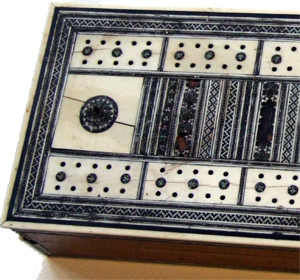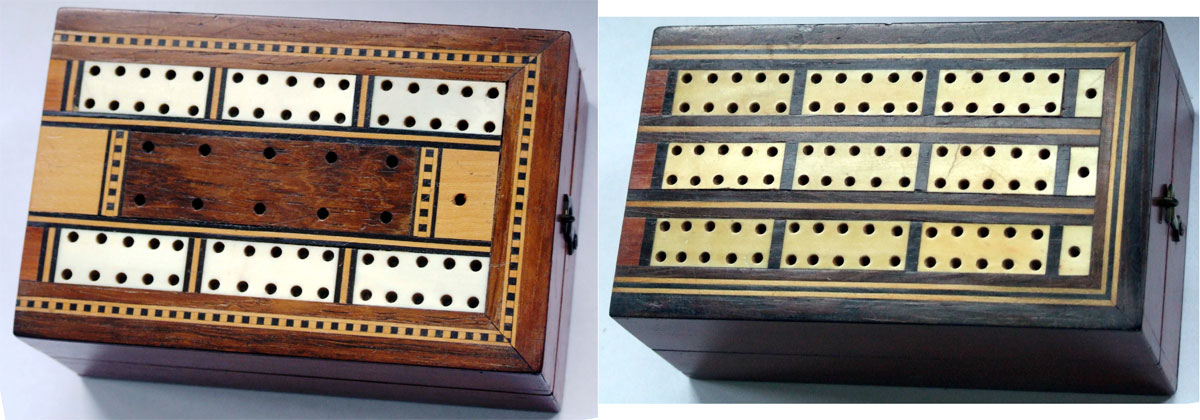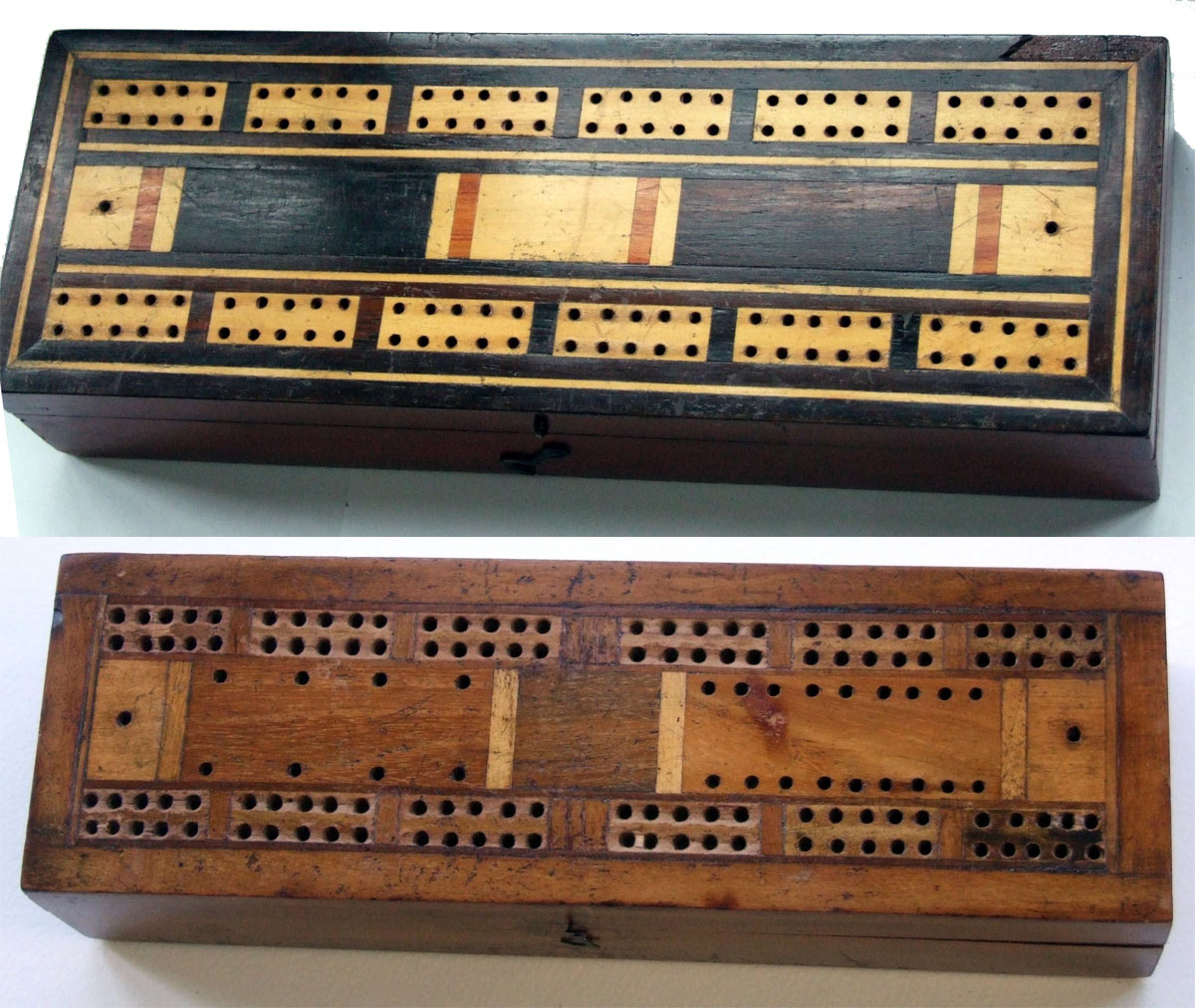Cribbage Board Collection
A collection of antique and vintage Cribbage Boards by Tony Hall

by Tony Hall
Cribbage was invented in the first half of the 17th Century but its heyday in Britain was probably from around the 1850s until the 1940s when parlour games were the main source of domestic entertainment. The game is still played in the UK in pubs and there are (apparently) local leagues playing both the five and six card version of the game. It is even more thriving in the States, being initially the game of choice in the US Navy, particularly in submarines for obvious reasons, and there is a National Association concerned with both play and board collection. I have a wide variety of cribbage boards in my collection of varying ages and interest. Some have significant age and specifications, a few are quite rare. Most of the boards date from the heyday of crib in Britain, although there are some earlier, some later. Most are commercially made; a few are shed work of varying qualities and interest.
However, the bulk of the collection is Victorian/Edwardian. Many of the single box and double box boards date from the 1880s to the 1920s. For example, the two and three-player single box boards (shown below). Both are commercially made from multiple woods and veneers, with bone or plastic inlays. Each has space for one pack of cards and a separate compartment for four or six bone or ivory pegs.

Above: single and double box cribbage boards. From the collection of Tony Hall.
In later years (in the 30s and 40s), many boards were produced for advertising drink or cigarettes.

Above: rare example of single cribbage box with advertising, offering the Season’s Greetings from the Criterion chain of wine and spirit shops operating (judging by the street names) throughout the Birmingham area. The design suggests any time from 1900-1920. From the collection of Tony Hall.
It is not unusual to find a single box in the shape of a horseshoe, although most also have a brass fan of four Ace cards in the centre (missing from this example). But my most exotic single box is made by Gulum Hussan, Kashmere, India and was probably used by the Brits during the Raj and found its way later to England (see below).

Above: single box cribbage boards, a) horseshoe shaped, b) made in India by by Gulum Hussan, Kashmere. From the collection of Tony Hall.
Most double boxes are commercially made to cater for two players, with two packs of cards and a central compartment for pegs and counters. They vary in quality from the highly polished veneered Victorian examples to more basic versions from the same period.

Above: two double box cribbage boards varying in quality from the highly polished veneered Victorian example and a more basic version from the same period. From the collection of Tony Hall.


By Tony Hall
Member since January 30, 2015
I started my interest in card games about 70 years ago, playing cribbage with my grandfather. Collecting card game materials started 50 years or so later, when time permitted. One cribbage board was a memory; two became the start of a collection currently exceeding 150!
Once interest in the social history of card games was sparked, I bought a wooden whist marker from the 1880s which was ingenious in design and unbelievably tactile. One lead to two and there was no stopping.
What happened thereafter is reflected in my articles and downloads on this site, for which I will be eternally grateful.
Related Articles

OXO Faces of the Millennium Dinner
Twentieth-century personalities promoting a millennium dinner at the Oxo Tower in London.

Kids Fun Box playing cards
Colourful cards for children with four non-standard suits connected with the natural world.

Tangle Foot Ale
Badger Brewery Tangle Foot strong ale advertising pack.

Scientific Whist
“Scientific Whist” : standard cards with instructions for play on the faces by Chas Goodall & Son, 1...

Agent Provocateur
Branded lingerie collection in a pack of pin-up playing cards.

Nimbus playing cards
Mike Steer’s weather-themed pack with suits in four colours and backs for cardistry.

Agatha Christie and Playing Cards revisited
Agatha Christie uses card-play as a primary focus of a story, and as a way of creating plots and mot...

The Decadent Deck
Studies in the eroticism of the female body by Inge Clayton.

Historic Shakespeare
“Historic Shakespeare” playing cards featuring Shakespearean characters by Chas Goodall & Son.

Copechat Paramount Sorting System
Preserving the past: a specimen deck showcasing edge-notched cards and their ingenious sorting syste...

Heartsette by Herbert Fitch & Co, 1893
A glimpse into a busy print and design office in late Victorian London.

Batman® playing cards
Batman playing cards published by InterCol of London 1989.

Can You Believe Your Eyes?
“Can You Believe Your Eyes?” playing cards featuring visual illusions & other oddities.

Pastime Playing Cards for the Blind
The “Pastime” Playing Cards for the Blind manufactured by Goodall & Son Limd., c.1910.

Songs with Flute accompaniment
Eighteenth century English engraved cards with music for voice and flute.

Love Tests
Vintage novelty “Love Test” cards of a slightly saucy nature but all in good fun!
Most Popular
Our top articles from the past 28 days






